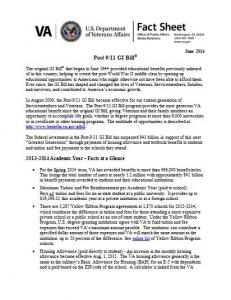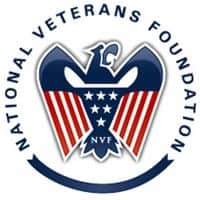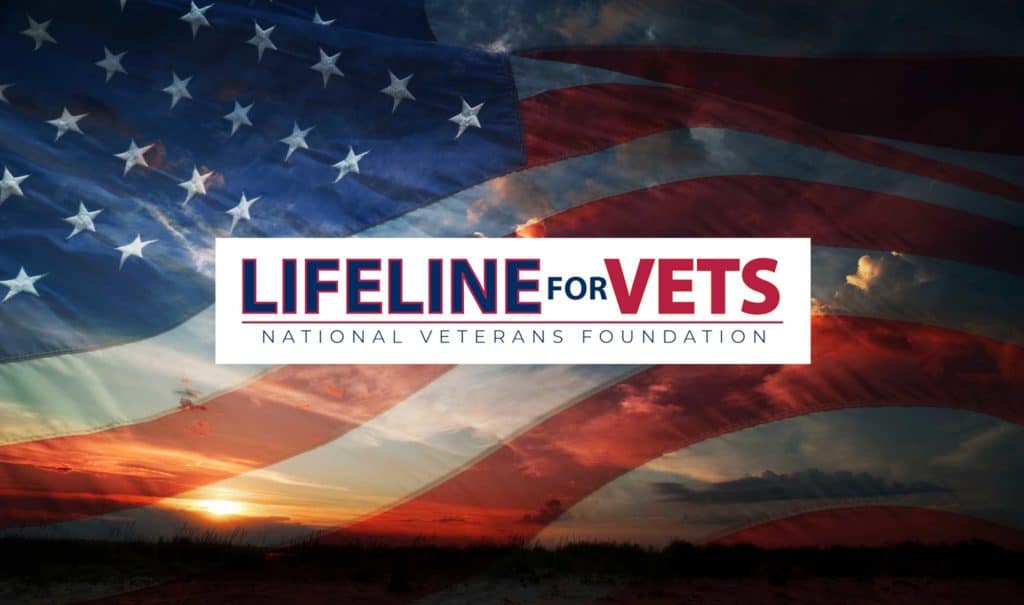GI Bill Fact Sheet June 2014
From the US Department of Veterans Affairs. Fact Sheet from the Department of Public Affairs – Media Relations
Post 9/11 GI Bill®
 The original GI Bill® that began in June 1944 provided educational benefits previously unheard of in this country, helping to create the post-World War II middle class by opening up educational opportunities to Americans who might otherwise not have been able to afford them. Ever since, the GI Bill has shaped and changed the lives of Veterans, Servicemembers, families, and survivors, and contributed to America’s economic growth.
The original GI Bill® that began in June 1944 provided educational benefits previously unheard of in this country, helping to create the post-World War II middle class by opening up educational opportunities to Americans who might otherwise not have been able to afford them. Ever since, the GI Bill has shaped and changed the lives of Veterans, Servicemembers, families, and survivors, and contributed to America’s economic growth.
In August 2009, the Post-9/11 GI Bill became effective for our current generation of Servicemembers and Veterans. The Post-9/11 GI Bill program provides the most generous VA educational benefit since the original GI Bill, giving Veterans and their family members an opportunity to accomplish life goals, whether in degree programs at more than 9,000 universities or in certificate or other training programs. The multitude of opportunities is described at https://www.benefits.va.gov/gibill.
The federal investment in the Post-9/11 GI Bill has surpassed $41 billion in support of this next “Greatest Generation” through payments of housing allowance and textbook benefits to students and tuition and fee payments to the schools they attend.
2013-2014 Academic Year – Facts at a Glance
- For the Spring 2014 term, VA has awarded benefits to more than 496,000 beneficiaries. This brings the total number of users to nearly 1.2 million with approximately $41 billion in benefit payments awarded to students and their educational institutions.
- Maximum Tuition and Fee Reimbursement per Academic Year (paid to school):
Pays all tuition and fees for an in-state student at a public university. It provides up to $19,198.31 this academic year at a private institution or at a foreign school. - There are 3,287 Yellow Ribbon Program agreements at 1,870 schools for 2013-2014, which reimburse the difference in tuition and fees for those attending a more expensive private school or a public school as an out-of-state student. Under the Yellow Ribbon Program, U.S. degree-granting institutions agree with VA to fund tuition and fee expenses that exceed VA’s maximum amount payable. The institution can contribute a specified dollar amount of those expenses and VA will match the same amount as the institution up to 50 percent of the difference. See online list of Yellow Ribbon Program schools.
- Housing Allowance (paid directly to student) ‑ An increase in the monthly housing allowance became effective Aug. 1, 2013. The VA housing allowance generally is the same as the military’s Basic Allowance for Housing (BAH) for an E-5 with dependents and is paid based on the ZIP code of the school. A calculator is linked from the VA website. The national average payment for the 2013-2014 school year is $1,429 a month. Students training at half-time or less are not eligible for the allowance, and students taking online classes only qualify for half of the average housing allowance, or $714.50. Students pursuing training at foreign schools full time will receive a $1,429 housing allowance equal to the average national BAH.
- Books and Supplies Stipend (paid directly to student). A books and supplies stipend of up to $1,000 yearly is paid proportionate to the hours of enrollment.
- More than 6,300 campuses among more than 3,600 educational institutions have committed to the Principles of Excellence (see below).
Principles of Excellence Improve Academic Environment for Veteran Students
By executive order in April 2012, President Obama defined a framework to strengthen oversight, enforcement, and accountability of education programs called Principles of Excellence. The principles are designed to ensure Servicemembers, Veterans, and their families have the information they need to make informed decisions concerning their educational benefits. Under the program, schools are asked to commit to providing meaningful information to Servicemembers, Veterans, spouses, and other family members about the cost and quality of educational institutions. They agree to avoid abusive and deceptive recruiting practices that target the recipients of federal military and Veterans’ educational benefits; to develop education plans for all participants in military and Veteran educational programs; and to designate a point of contact for academic and financial advice at each school. To see if a school participates in the Principles of Excellence program use the GI Bill comparison tool.
Delivery of Education Benefits Gains in Speed
- VA works diligently to meet the needs of our Servicemembers, Veterans, and their families. Over the past two years, VA developed and implemented a new technology solution (the Long Term Solution) to improve the processing of Post-9/11 GI Bill claims.
- The Long Term Solution now processes over 40 percent of Post-9/11 GI Bill enrollments through end-to-end automation.
- VA’s performance improvement is illustrated in the average processing times:
- For students new to VA, average wait time in Fiscal Year 2013 was 26.2 days, down from 30.5 days in FY12.
- For students reenrolling, the FY13 average wait time was 9.7 days, down from 16.5 days in FY12.
Improved Consumer Information for Prospective Students
VA is improving tools to help beneficiaries learn more about their vocational aptitudes and to select an educational institution.
- CareerScope® is a free, new tool featured on the website that measures a student’s aptitude and interests through a self-administered online test, identifying potential career paths.
- The “Factors to Consider When Choosing a School” guide, also available on the website, offers future students steps to take when researching, choosing, and attending a school.
- The new GI Bill® Comparison Tool on the website allows students to research and compare schools, including key indicators like average student loan debt and graduation rates.
New Online Complaint System Empowers Students, Strengthens Enforcement
The Departments of Veterans Affairs, Defense, Education and Justice, along with the Consumer Financial Protection Bureau and the Federal Trade Commission have launched a new online complaint system designed to collect feedback from Veterans, Servicemembers and their families who are experiencing problems with educational institutions receiving funding from Federal military and veterans educational benefits programs, including benefits programs provided by the Post-9/11 GI Bill and the DoD Military Tuition Assistance Program. The centralized online reporting system is designed for Veterans, Servicemembers and eligible dependents to report negative experiences with educational institutions; and gives the federal government the information needed to identify and address unfair, deceptive, and misleading practices and ensure high quality academic and student support services are available for veterans, service members, and their families.
Background on Post-9/11 GI Bill Benefits
The Post-9/11 GI Bill provides financial support for education and housing expenses to individuals with at least 90 days of aggregate service after September 10, 2001, or individuals discharged with a service-connected disability after 30 days.
To be eligible for 100 percent of the benefit, an individual must have served an aggregate of 36 months of active duty service, or have been discharged for a service-connected disability after 30 days of continuous service after September 10, 2001. NOTE: Active-duty service time required by graduates of a Service Academy or ROTC does not count toward the three years necessary to qualify for full benefits.
Approved training under the Post-9/11 GI Bill includes:
- Graduate and undergraduate degrees,
- Vocational/technical training,
- On-the-job training,
- Flight training,
- Correspondence training,
- Licensing and National Testing programs,
- Entrepreneurship training and Tutorial Assistance.
All training programs must be approved for GI Bill benefits. To see what programs are currently approved for VA benefits, go to our website, benefits.va.gov/gibill and click “Choose a School.”
The period of eligibility for the Post 9/11 GI Bill ends 15 years from the date of the last discharge or release from Active Duty of at least:
- 90 consecutive days
- 30 days but less than 90 days if released for a service-connected disability
Or: 15 years from the date of discharge for the last period of active duty service used to determine eligibility to meet the minimum service requirements of 90 aggregate days of service.
Who is eligible for benefits under the Post-9/11 GI Bill?
For those who served fewer than 36 months, the percentage of benefit ranges from 40 percent to 90 percent:
- 90 percent – 30 total months (including service on active duty in entry level and skill training)
- 80 percent – 24 total months (including service on active duty in entry level and skill training)
- 70 percent – 18 total months (excluding service on active duty in entry level and skill training)
- 60 percent – 12 total months (excluding service on active duty in entry level and skill training)
- 50 percent – 6 total months (excluding service on active duty in entry level and skill training)
- 40 percent – 90 or more days (excluding service on active duty in entry level and skill training)
For example, an individual with five months of qualifying service could receive 40 percent of the tuition benefit, 40 percent of the monthly housing allowance, and a maximum of $400 in a books and supplies stipend.
Veterans must have an honorable discharge to be eligible.
The Post-9/11 GI Bill allows Servicemembers (officer or enlisted, Active Duty or Selected Reserve), on or after August 1, 2009, to transfer unused education benefits to immediate family members (spouse and children). As this benefit was designed to support recruitment and retention in the Armed Forces, transferability policy is determined by the Department of Defense (DoD) and the military services.
What benefits do students receive under the Post-9/11 GI Bill?
Depending on each individual’s situation, benefits could include payment of tuition and fees, a monthly housing allowance, a stipend for books and supplies, a rural benefit payment, and a Yellow Ribbon benefit.
Post-9/11 GI Bill benefits differ from other education assistance programs in that each type of payment is issued separately, with some payments made directly to the school, on behalf of the individual, and others issued directly to the individual.
• Tuition and Fees: Full tuition and fees paid directly to the school for all public school in-state students. For those attending private or foreign schools, tuition and fees are capped at the national maximum rate.
• Monthly housing allowance: A Monthly Housing Allowance (MHA) is generally the same as the military Basic Allowance for Housing (BAH) for an E-5 with dependents. The MHA is based on the ZIP code of the school. This payment is issued directly to the student at the beginning of each month for education and training pursued the previous month. The amount is prorated based on the rate of pursuit (i.e. full-time.). NOTE: Active duty personnel are not eligible for the Post-9/11 GI Bill monthly housing allowance.
• Books and supplies stipend: An annual books and supplies stipend – paid to the student ‑ up to $1,000, paid proportionately based on enrollment. This payment is issued directly to the student when the school certifies and VA processes the enrollment.
• Yellow Ribbon payments: For those attending a more expensive private school or a public school as an out-of-state student, a program exists which may help to reimburse the difference. This program is called the Yellow Ribbon Program. This program allows institutions of higher learning (degree-granting institutions) in the United States to enter voluntarily into an agreement with VA to fund tuition and fee expenses that exceed VA’s maximum amount payable. The institution can contribute a specified dollar amount of those expenses and VA will match the same amount as the institution not to exceed 50 percent of the difference.
Only individuals entitled to the maximum benefit level (based on service requirements) may receive this funding. Active Duty members, spouses of Active Duty members eligible for Transfer of Entitlement and Fry Scholarship recipients are not eligible.
• Rural benefit payments: A one-time rural benefit payment of $500 to individuals who reside in a county with six persons or fewer per square mile (as determined by the most recent decennial census), and who either:
- Physically relocate at least 500 miles to attend an educational institution or
- Relocate by air to attend an educational institution (if no other land-based transportation exists.)
For the original posting and more information visit https://www.va.gov/opa/publications/factsheets.asp
You can be a part of our mission to help Veterans by making a tax-deductible donation!
About the Author
SUBSCRIBE TO OUR BLOG AND NEWS!
By submitting this form, you are granting: NATIONAL VETERANS FOUNDATION INC permission to email you. You may unsubscribe via the link found at the bottom of every email. (See our Email Privacy Policy for details.)
Related Posts





